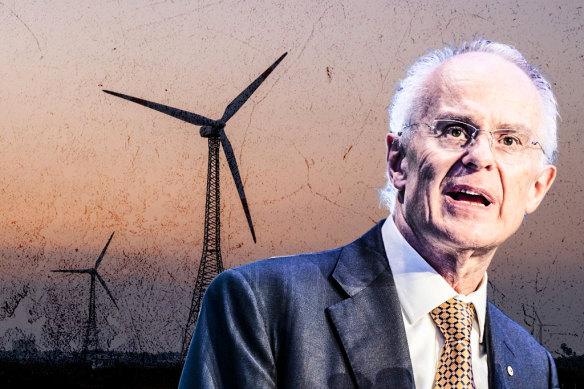
Australia needs the trifecta: lowest cost, reliable and zero-emission electricity. Given that we now have a debate about the merits of two very different zero-emission technologies, renewables versus nuclear, we seem agreed on the need for zero-emission electricity.
When we seek lowest cost and reliable electricity, Australia’s huge natural advantage of best-in-world solar and wind, combined with a range of technologies to firm these, are clearly the superior option.
Solar and wind can supply power at about $60-80 a megawatt hour, much cheaper in some areas. When this is firmed so that we have 24/7 reliable electricity using, say, pumped hydro, batteries or gas-fired peaking generation, the cost rises to about $110MWh. This is all known technology and much in use in Australia today.

Former ACCC chair Rod Sims says the comparative cost of nuclear energy makes it a bad choice for Australia.Credit: Jamila Toderas/Bloomberg
With recently built nuclear plants in the US, UK and the European Union, nuclear power comes in at $200-$300MWh, at best, based on running 90 per cent of the time, and that is in countries that already have nuclear power. In the CSIRO’s most recent analysis of nuclear power costs, it uses the capital costs in South Korea based on what is achievable from that country’s continuous builds of nuclear power plants and the benefits of learning as it goes. South Korea also produces most components of the nuclear value chain, so it has expertise on all aspects of the plant readily available.
On this basis, the CSIRO finds that nuclear is only 1.5 to two times more expensive than firmed renewables. However, it acknowledges that building initial nuclear plants could cost as much as 100 per cent more than it assumes in its analysis. It also acknowledges that South Korea’s costs are much lower than nuclear build costs in Western countries. For planning purposes, therefore, we should consider nuclear in Australia as at least three times more expensive than firmed renewables, not the 1.5 to two times used by CSIRO.
Of course, countries with old nuclear plants will have lower costs than those embarking on new nuclear builds. The average age of nuclear plants in France is close to 40 years. Even with this history, however, the latest nuclear plant in France – Flamanville – came in at four times the predicted price and 12 years late. Indeed, of the five third-generation nuclear plants built this century in Western counties, all have had huge cost and time overruns. Their experience should guide Australia now.
Loading
Coalition policy is to build the new plants by 2035-37, which is unrealistic, according to the vast majority of experts and recent experience in Western economies. Australia needs low-cost and reliable electricity now, and can’t wait up to two decades for nuclear to be built. Further, in Western countries with which we compare ourselves, the cost of nuclear power is trending higher on average as more is built. This contrasts with renewables, for which the costs have been continually falling – by about 90 per cent for solar and 70 per cent for wind since 2010.









 Add Category
Add Category